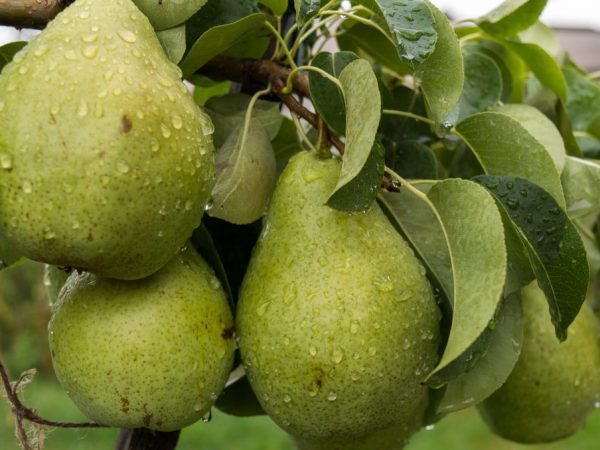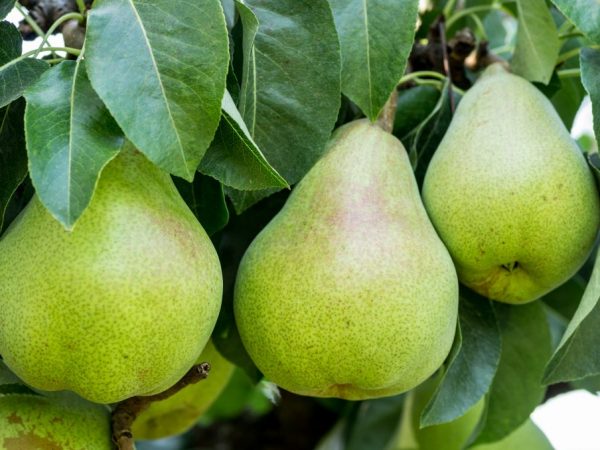Characteristics of varieties of large pears
Among the variety of species, gardeners prefer large varieties of pears. This is not surprising, because large varieties of pears give high quantitative indicators of productivity.
- Bere Diehl
- Description of the tree
- Description of the fetus
- Advantages and disadvantages
- Large-fruited Susova
- Description of the tree
- Description of the fetus
- Advantages and disadvantages
- Bere Ardanpon
- Description of the tree
- Description of the fetus
- Advantages and disadvantages
- Pear Veles
- Description of the tree
- Description of the fetus
- Advantages and disadvantages
- Conclusion

Characteristics of varieties of large pears
Bere Diehl
Pollinators of the Bere Diehl variety can be the following varieties: Lyubimitsa Klappa, Saint-Germain, Bere Ardanpon. The variety itself does not play such a role, since its pollen is unsuitable for this process.
According to the description, the plant enters the fruiting phase 6-7 years after planting. If vaccinated on quince - in 4-5 years. Autumn species, its technical ripeness occurs in late September-early October. Full ripening - at the end of October. Fruits are stored for 55 to 65 days.
Description of the tree
Tall tree. The fastest development occurs in the early stages. The crown is pyramidal, dense. The branches are medium in size, brownish gray. Their ends hang down. Shoots are brownish gray, smooth. Lentils are infrequent, large, light-colored. The leaves are large, wide, ovate. The tips are shortly pointed. Their petioles are long, thin.
Description of the fetus
Pear-shaped fruits. Wide, swollen in the middle, narrowed towards the apex, uneven. Large: their weight ranges from 250 to 500 grams. The color is greenish yellow. Small rusty spots on the surface are characteristic, which merge into a single spot near the tail. There may be a slight blush on one side.
The skin is dense, thin. The peduncle is of medium length, thick, slightly curved.
The pulp is juicy, mellow, sweet with sourness. The density is average. The skin color is white.
Advantages and disadvantages
The variety is positively characterized by the following properties:
- high yield: depending on the region of cultivation and age, from 140 to 320 kg of pears are harvested from the tree;
- large-fruited.
Negative characteristics include:
- frost resistance of the average level;
- exacting care;
- shedding of fruits;
- the species is affected by diseases such as scab and fire blight.
Large-fruited Susova

The fruits have a pleasant aroma
Another name is Autumn Susova.
According to the description, a tree of this variety begins to bear fruit in 5-6 years. The variety is late autumn. Fruits ripen by September. At low temperatures, they remain fresh until the beginning of winter. The following varieties are pollinators: Autumn Yakovleva, Chizhevskaya, Vidnaya.
Description of the tree
Small tree. Its crown is wide, pyramid-shaped, rounded. Leafiness of medium density. Shoots are weakly whitened, strongly developed, thick. The internodes are short, greenish-yellow.
Description of the fetus
Pear-shaped, rounded. Fruit weight reaches 250 g, there is a slight ribbing. The skin is dense, yellow-green in color. The fruits have a blurred striped blush. There are many small dots under the skin. The pulp is juicy, dense, white. The taste is sweet and sour.The aroma is pleasant.
Advantages and disadvantages
Positive characteristics include:
- stable yield indicators - up to 50 kg of pears from a tree;
- large-fruited;
- great taste;
- good preservation;
- frost resistance;
- resistance to scab and gall mites.
The disadvantages of Large-fruited Susova include the fact that it cannot withstand severe frosts.
Bere Ardanpon
According to the description, Bere Ardapon is a winter variety. The first fruits are consumed 8-9 years after planting. If a graft is made on quince, then after 5 years.
Dessert variety. The best pollinators are the well-known species: Williams, Forest Beauty, Winter Decanka.

Fruits are stored for a long time
The fruits stick well to the tree until they reach full maturity, then they begin to crumble. Fruits are harvested, depending on the growing region: from the first days of September to 20 October. Full maturation occurs in early November. The crop remains presentable until mid-winter.
The variety gives the best yield indicators when grown on the territory of the southern coast of Crimea.
Description of the tree
The plant is tall. The crown is pyramidal, dense. The bark is grayish brown, scaly. Lentils are frequent, yellow. The branches are thick, drooping, brown-green. Shoots are thin. The leaf buds are pointed. Leaves are oval, oblong, dark green, small. The surface is glossy, the edges are pointed. Inflorescences are up to 10 white flowers.
Description of the fetus
Pear-shaped, wide. The weight is 170-220 g. There are many bumps on the surface. The color is light yellow, the subcutaneous points are brown. There is a pale pink spot on one side. The saucer is deep, of medium width. The peduncle is thick, medium-sized, curved. The pulp is white, juicy and melting. The taste is sweet and sour, with a slight pleasant astringency.
Advantages and disadvantages
The winter pear Bere Ardanpon has many positive properties. Among them are:
- good yield indicators - from 1 hectare harvested from 120 to 180 centners;
- long shelf life of fruit;
- great taste.
The variety also has negative characteristics. These include average winter hardiness. The flowers also cannot withstand frost. Leaves and fruits are exposed to scab. It is transmitted when the species is used in breeding. The culture is very demanding on land and ambient temperature. Not fast-growing.
Pear Veles
The Veles pear is capable of self-pollination, but to improve the yield, the following species are planted nearby: Chizhovskaya, Rogneda, Voskresenskaya large, Severyanka, Prosto Maria. They are excellent pollinators.
Fruiting occurs 6-7 years after planting. Pears ripen in late summer and early autumn.
Description of the tree
The culture is medium-sized, grows up to 4 m. The crown is spreading in the early stages of development. As it matures, the plant acquires a pyramidal shape. Average leafiness. The branches are thick and long, curved. Shoots are brownish brown. The leaves are dark green, small. The edges are finely serrated. Their surface is smooth.
Description of the fetus
The shape is pear-shaped. The fruits are wide, not ribbed. The average weight is 170 g, larger fruits reach 200 g. The skin is smooth, shiny. The color is light green with a pale blush at the stage of technical maturity. When fully ripe, it is yellow with a reddish tint. The pulp is juicy, semi-oily, medium density, creamy. The taste is sweet, with a slight sourness.
Advantages and disadvantages
The following advantages of the variety can be distinguished:
- high productivity;
- frost resistance;
- storage duration;
- good immunity to fungi;
- universality of use.
Pears have few drawbacks. First of all, they include delayed fertility. The kidneys tend to freeze. As they grow older, the fruits become smaller.
Conclusion
The variety of large-fruited pear varieties allows you to choose the most suitable one. Such pears can be found among summer, autumn and winter species.In addition to the above, there are many other popular varieties: Marianna, Marshal Zhukov, Kozelskaya large, Lyubimitsa Klappa, Vidnaya, Kosmicheskaya.


